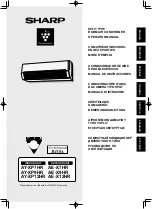
E-13
ENGLISH
INDOOR TEMP. OUTDOOR TEMP.
COOLING
upper
limit
32
˚
C 46
˚
C
lower
limit 21
˚
C –10
˚
C
HEATING
upper limit
27
˚
C 24
˚
C
lower
limit
–
–15
˚
C
• The built-in protective device may prevent the unit
from operating when used out of this range.
• Condensation may form on the air outlet if the unit
operates continuously in the COOL or DRY mode
when humidity is over 80 percent.
ADDITIONAL NOTES ON
OPERATION
OPERATING TEMPERATURE RANGE
BEFORE CALLING FOR
SERVICE
The following conditions do not denote equip-
ment malfunctions
UNIT DOES NOT OPERATE
The unit will not operate if it is turned on immediately
after it is turned off. The unit will not operate
immediately after the mode is changed. This is to
protect the internal mechanisms. Wait 3 minutes
before operating the unit.
UNIT DOES NOT SEND OUT WARM AIR
The unit is preheating or de-icing.
ODORS
Carpet and furniture odors that entered into the unit
may be sent out from the unit.
CRACKING NOISE
The unit may produce a cracking noise. This sound
is generated by the friction of the front panel and
other components expanding or connecting due to a
temperature change.
A LOW BUZZING NOISE EMITTED
This is a sound emitted when the unit is generating
Plasmacluster ions.
SWISHING NOISE
The soft, swishing noise is the sound of the refrigerant
fl
owing inside the unit.
WATER VAPOUR
• In the COOL and DRY operation, water vapour
can sometimes be seen at the air outlet due to the
difference between the room air temperature and
the air discharged by the unit.
• In the HEAT operation, water vapour may
fl
ow out
of the outdoor unit during de-icing.
THE OUTDOOR UNIT DOES NOT STOP
After stopping the operation, the outdoor unit will
rotate its' fan for about a minute to cool down the unit.
ODOR EMITTED FROM THE PLASMACLUSTER
AIR OUTLET
This is the smell of ozone generated from the
Plasmacluster Ion generator. The ozone concentration
is very small, posing no adverse effect on your
health. The ozone discharged into the air rapidly
decomposes, and its density in the room will not
increase.
If the unit appears to be malfunctioning, check the
following points before calling for service.
IF THE UNIT FAILS TO OPERATE
Check to see if the circuit breaker has tripped or the
fuse has blown.
IF THE UNIT FAILS TO COOL (OR HEAT) THE
ROOM EFFECTIVELY
• Check the
fi
lters. If dirty, clean them.
• Check the outdoor unit to make sure nothing is
blocking the air inlet or outlet.
• Check the thermostat is proper setting.
• Make sure windows and doors are closed tightly.
• A large number of people in the room can prevent
the unit from achieving the desired temperature.
• Check whether any heat-generating appliances are
operating in the room.
IF THE UNIT FAILS TO RECEIVE THE REMOTE
CONTROL SIGNAL
• Check whether the remote control batteries have
become old and weak.
• Try to send the signal again with the remote control
pointed properly towards the unit’s signal receiver
window.
• Check whether the remote control batteries are
installed with the polarities properly aligned.
Please call for service when OPERATION lamp,
TIMER lamp and/or PLASMACLUSTER lamp on
the unit blink.
WHEN POWER FAILURE OCCURS
This air conditioner has a memory function to store
settings when a power failure occurs.
After power recovery, the unit will automatically re-
start in the same settings which were active before
the power failure, except for timer settings.
If the timers were set before a power failure, they will
need to be re-set after power recovery.
PREHEATING FUNCTION
In the HEAT operation, the indoor fan may not start
for two to
fi
ve minutes after the unit is turned on to
prevent cold air from blowing out of the unit.
DE-ICING FUNCTION
• When ice forms on the heat exchanger in the
outdoor unit during the HEAT operation, an
automatic de-icer provides heat for about 5 to 10
minutes to remove the ice. During de-icing, the
inside and outside fans stop operating.
• After de-icing is completed, the unit automatically
resumes operation in the HEAT mode.
HEATING EFFICIENCY
• The unit employs a heat pump that draws heat from
the outside air and releases it into the room. The
outside air temperature therefore greatly affects the
heating ef
fi
ciency.
• If the heating efficiency is reduced due to low
outside temperatures, use an additional heater.
• It takes time to warm up and heat the entire room
because of the forced air circulation system.
BEFORE CALLING FOR
SERVICE
















































